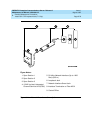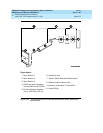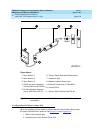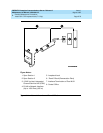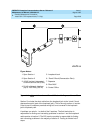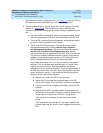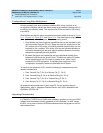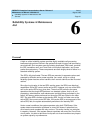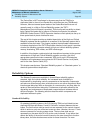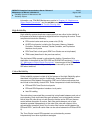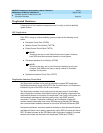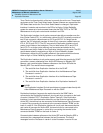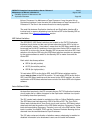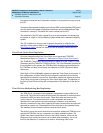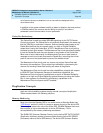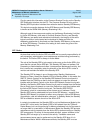
DEFINITY Enterprise Communications Server Release 6
Maintenance for R6vs/si
555-230-127
Issue 1
August 1997
Reliability Systems: A Maintenance Aid
Page 6-2Reliability Options
6
The Packet Bus is NOT duplicated in the same way that the TDM Bus is
duplicated (that is, there is one Packet Bus, while there are two TDM Buses).
However, there are several spare leads on the Packet Bus itself that are not
normally used. In a High or Critical Reliability system, the TN771
Maintenance/Test circuit pack is provided. This circuit pack has ability to detect
faulty Packet Bus leads and to instruct all Packet circuit packs (for example
ISDN-BRI, Packet Control, TN570 Expansion Interface circuit packs) to use up to
three spare leads in place of defective ones.
The rest of this chapter provides a detailed description of the High and Critical
Reliability systems that are available in as well as of the Standard system that is
available across the board. The chapter explains the duplicated hardware and
includes a description of the TN772 Duplication Interface circuit pack. It provides
a look at the following concepts relevant to high and critical reliability systems:
memory shadowing, SPE modes, and SPE-interchanges.
In addition, this chapter contains technical descriptions important to the general
maintenance of High and Critical Reliability systems, such as a list of the
appropriate system technician commands, SPE circuit pack LED strategies,
installation and replacement procedures for SPE Control Carrier circuit packs,
and for the Inter-Carrier Cable (ICC).
This chapter uses the term “Standard Reliability system” or “Standard system” to
denote a system without duplication.
Reliability Options
The Release 5 systems are available in three different reliability options:
standard, high and critical reliability. An increased level of reliability is
implemented by duplicating various components so that standby components
can take over (interchange) when a failure occurs on an active component. Most
interchanges take place with no disruption of current service, and they allow for
repairs to be made without disruption. Furthermore, duplication allows for the
upgrading and maintenance of duplicated components and software without
service disruption. The following sections describe which components are
duplicated with each option.
Standard Reliability
On standard reliability systems, the 512-time-slot TDM bus is divided into two
duplicate 256-time-slot buses, A and B. Call traffic is shared between the two
buses. The first five time slots on each bus are reserved for the control channel,
which is active on only one of the two buses at a time. Likewise, the next 17 time
slots are reserved for carrying system tones. The tone time slots are not
necessarily on the same bus (A or B) as the control channel. If any failure that
affects the ability of the active control channel or the tone time slots to function
takes place, the other bus becomes active for those time slots. For more



